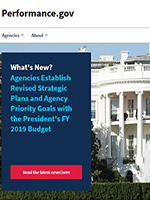
Agencies Reveal New Priority Goals in Budget

The GPRA Modernization Act requires agencies to develop a set of 3-5 two-year priority goals and the Trump Administration posted its first set of goals for major agencies on an updated performance.gov website at the same time the FY 2019 budget was released. But the goals didn’t get the same billing as the budget
The website’s structure and navigability were taken to task by the Government Accountability Office, which described it as not very user-friendly in one report in 2013 and a second report in 2016. When the Trump Administration took office, it suspended quarterly updates on the priority goals it inherited from the Obama Administration. It then launched a re-think of the design of the website, led by a team from 18F. Their work should be finished by Fall 2018, so the content refresh is on a fairly static website that they acknowledge is still not very user-friendly.
Nevertheless, the site provides links to agencies’ four-year strategic plans and objectives (for the period FY 2018 – 2022), and two-year Agency Priority Goals (for the period FY 2018-2019).
Here is a link to a summary table of the agency strategic plans. Note that of the 23 major agencies, 6 have still not yet posted their new strategic plans.
In addition, here is a link to a summary table of Agency Priority Goals (APGs). Two agencies have not yet posted their goals (the Department of Energy and the Department of Health and Human Services). There are a total of 74 APGs listed, in comparison to 91 that were posted by the Obama Administration’s agencies for the FY 2016-2017 period. Nearly one-third of the Trump Administration’s APGs focus on the same priority areas as those in the Obama Administration, but with different degrees of emphasis. For example:
Commerce. The Commerce Department’s APG for accelerating patent processing is:
By September 30, 2019, the U.S. Patent and Trademark Office will reduce patent pendency to less than 15 months for first action pendency and less than 24 months for total pendency from end of fiscal year 2017 results of 16.3 months and 24.2 months, respectively.
In comparison, the same goal in the Obama Administration was:
By September 30, 2017, the Patent and Trademark Office will reduce patent pendency to less than 14 months for first action and less than 23 months for total pendency from end of fiscal year 2014 results of 18.4 and 27.4 months. This priority goal supports the Department of Commerce’s longer-term goal focused on achieving 10 months for first action pendency and 20 months for total pendency by FY2019.
Housing and Urban Development. HUD’s APG for homelessness is:
Reduce the average length of homelessness in communities by an average of 3 days by the end of FY 2019.
In comparison, the homeless reduction goal in the Obama Administration was:
In partnership with other agencies, the Department of Housing and Urban Development will reduce the total number of homeless families, youth and children, and people experiencing chronic homelessness, as well as keep the number of Veterans living on the street at zero (as measured by the 2018 Point-in-Time count).
State Department. State’s food security APG is:
Increase food security and resilience in Feed the Future countries. By September 30, 2019, Feed the Future will exhibit an average reduction in the prevalence of poverty and stunting of 20 percent, across target regions in Feed the Future’s focus countries, since the beginning of the initiative in FY 2010.
In comparison, the food security goal in the Obama Administration was:
Increase food security in Feed the Future initiative countries. By September 30, 2017, 10 out of 19 Feed the Future-focus countries will exhibit reductions of 10 percent or greater in the prevalence of poverty or stunting in their zones of influence, compared to the 2011-2012 baseline study results.
Priority Goals in New Areas. The Trump Administration has developed some Agency Priority Goals that were not reflected in the Obama Administration’s APGs. For example, the State Department has added a bold goal:
Achieve control of the HIV epidemic. By September 30, 2019, new infections are fewer than deaths from all causes in HIV-positive patients in up to 13 high-HIV burden countries through leadership by State and implementation by USAID; the U.S. Department of Health and Human Services and its Agencies, including the Centers for Disease Control and Prevention, the Health Resources and Services Administration, and the National Institutes of Health; the Departments of Defense, Labor, and Treasury; and the Peace Corps.
Other new priority goals are tied to well-known Trump Administration priorities such as reducing regulatory burdens, enhancing Southern border security, and improving the processing of drilling applications on public lands.
Agencies have already begun implementing their APGs and will be reporting their first quarter’s progress for FY 2018 in a few weeks, so be sure to visit performance.gov for updates.



